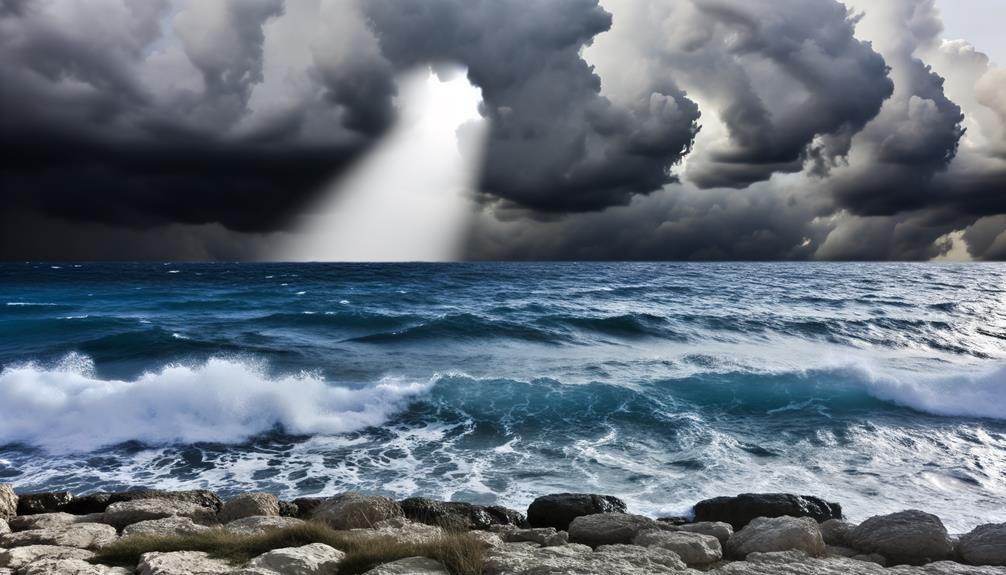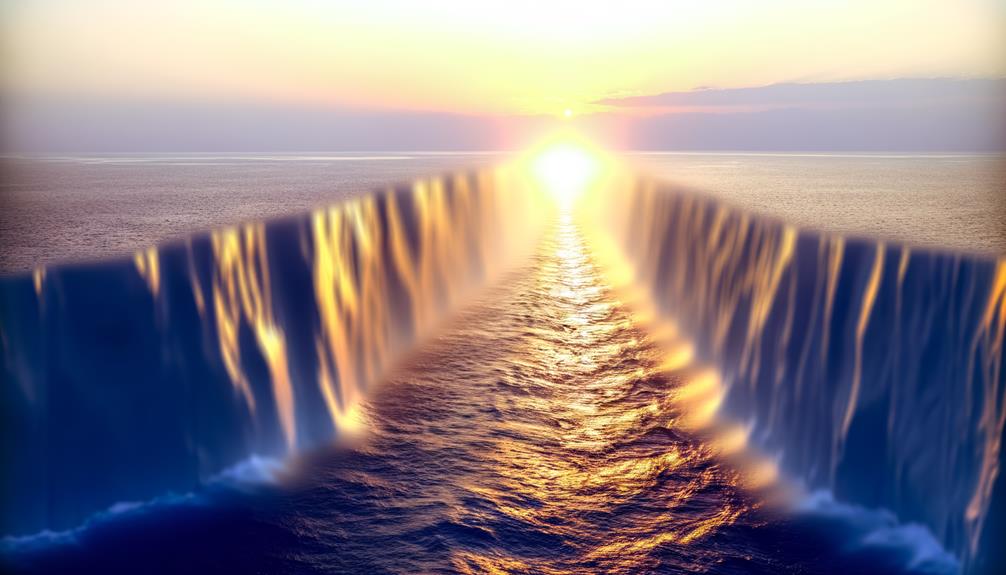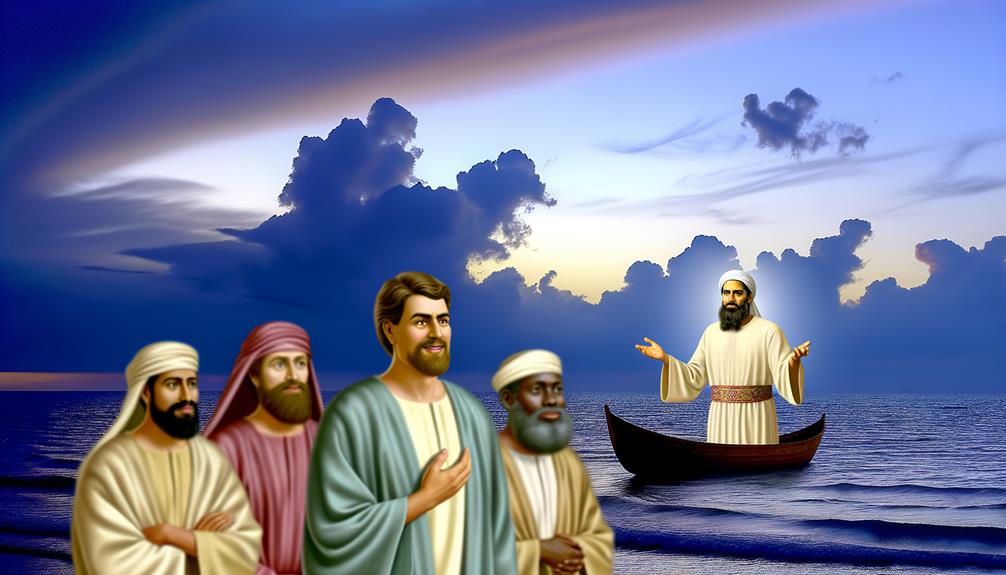Meaning Of Sea In The Bible: Spiritual Depths
In the Biblical context, the sea symbolizes chaos and danger, as seen in Genesis where primordial waters represent a formless void. It signifies human frailty and the unpredictable nature of life, depicted in events such as the Red Sea crossing and Jonah’s ordeal.
Divine sovereignty over these chaotic elements is a recurrent theme, illustrated in Psalms and Jesus calming the storm in the Gospels. Eschatologically, Revelation portrays the sea as a source of peril to be vanquished in the new creation.
This complexity offers rich insights into divine power, human vulnerability, and ultimate redemption. Explore further to uncover deeper meanings.

Biblical Meaning of the Sea: Symbolism and Spiritual Significance
| Aspect | Details |
|---|---|
| Term | Sea |
| Biblical References | Genesis 1:10, Revelation 21:1, Psalm 89:9, Exodus 14:21 |
| Literal Meaning | Large body of water; ocean or sea |
| Symbolism | Chaos, mystery, divine power, judgment, separation, or nations |
| Spiritual Meaning | Often represents the unknown, trials, and God’s sovereignty over nature |
| Prophetic Use | Used in Revelation to symbolize multitudes or separation |
Symbolism of the Sea

In biblical literature, the sea often symbolizes chaos, danger, and the unknown, reflecting its unpredictable and tumultuous nature in the ancient world. This symbolism is evident in various scriptural passages where the sea serves as a metaphor for existential threats and divine sovereignty.
For instance, in Genesis, the primordial waters represent the formless void before creation, embodying a state of disorder. Similarly, in the Psalms, the sea is depicted as a menacing force subdued by God’s power, illustrating divine control over chaos.
The Book of Revelation further portrays the sea as a domain of peril, reinforcing its association with adversity and mystery.
Consequently, the sea in biblical texts encapsulates a rich tapestry of meanings, central to understanding ancient cosmological perspectives.
Sea as Chaos

In biblical literature, the sea frequently symbolizes disorder and unpredictability, embodying the primordial chaos that preexists creation.
This chaotic nature of the sea not only underscores the divine power exerted by God to bring order but also highlights human vulnerability in the face of natural forces.
Symbol of Disorder
Depictions of the sea in biblical texts frequently symbolize chaos and disorder, reflecting the ancient Near Eastern understanding of the sea as a primordial force of instability. This symbolic representation is evident in numerous scriptural passages where the tumultuous nature of the sea serves as a metaphor for unpredictability and destruction.
The biblical imagery of the sea encapsulates humanity’s struggle against uncontrollable natural forces, evoking fear and reverence. To illustrate this, consider the following examples:
| Scriptural Reference | Description of Chaos |
|---|---|
| Genesis 1:2 | “The earth was formless and empty, darkness was over the surface of the deep…” |
| Psalm 93:3-4 | “The seas have lifted up, O Lord, the seas have lifted up their voice…” |
| Isaiah 57:20 | “But the wicked are like the tossing sea…” |
| Revelation 21:1 | “There was no longer any sea.” |
These passages underscore the sea’s embodiment of disorder and an unpredictable threat in biblical narratives.
Divine Power Displayed
The biblical narratives frequently utilize the imagery of the sea to exemplify divine authority over chaotic forces, emphasizing God’s supreme power in subduing and controlling the elements of disorder.
In Genesis, God separates the waters, establishing cosmic order from primordial chaos. Similarly, the Psalms often depict God’s sovereignty over tumultuous seas, as seen in Psalm 89:9, where He stills the roaring waves.
The New Covenant continues this theme; Jesus calming the storm in Mark 4:39 serves as a profound demonstration of divine mastery over nature’s chaos.
These instances underscore a theological assertion that God’s omnipotence extends over all creation, reinforcing the belief in a deity who not only creates but also maintains order amidst chaos.
Human Frailty Highlighted
Biblical texts often portray the sea as a symbol of chaos, illustrating human vulnerability in the face of overwhelming and uncontrollable natural forces. This portrayal underlines the human experience of frailty and helplessness against the vast, tumultuous expanse of the sea.
Scriptural narratives often employ this imagery to emphasize the precarious nature of human existence and the limits of human power. For instance, amid turbulent waters, human efforts appear insignificant, underscoring a profound dependence on divine intervention.
- The Red Sea crossing (Exodus 14): Demonstrates the Israelites’ helplessness and God’s salvific power.
- Jonah’s ordeal (Jonah 1-2): Highlights human vulnerability and the need for divine mercy.
- Jesus calming the storm (Mark 4:35-41): Reveals human fear and divine authority.
- Psalm 107:23-30: Depicts sailors’ distress and God’s deliverance.
Sea and Deliverance

Throughout biblical narratives, the sea frequently serves as a symbol of divine deliverance, illustrating the profound relationship between God’s intervention and the liberation of His people.
Importantly, the parting of the Red Sea in Exodus epitomizes this theme, where God miraculously enables the Israelites to escape Egyptian bondage, underscoring His sovereign power and commitment to their freedom.
Additionally, Jonah’s deliverance from the belly of the fish, after being cast into the stormy sea, further exemplifies God’s capacity to rescue and redeem.
These instances reflect the theological motif that God’s authority over the chaotic seas signifies His ability to bring salvation, transforming perilous circumstances into opportunities for divine rescue and reaffirming His covenantal promises.
Jesus Calms the Sea

The account of Jesus calming the sea, as recorded in the synoptic Gospels, serves as a profound demonstration of divine authority over nature, illustrating Jesus’ command over the elements.
This narrative also underscores the theme of faith amidst turmoil, as the disciples’ fear contrasts with Jesus’ serene confidence.
Additionally, the incident symbolically represents the establishment of peace and order, transcending mere physical calm to suggest spiritual tranquility.
Demonstration of Divine Authority
In the Gospel narratives, the account of Jesus calming the sea serves as a profound demonstration of His divine authority over the natural world. This episode, documented in the Synoptic Gospels, emphasizes Jesus’ power and divinity through the following key aspects:
- Immediate Reaction: At Jesus’ command, the wind and waves ceased instantly, underscoring His sovereignty over creation.
- Disciples’ Awe: The disciples’ astonishment and reverence reflect the recognition of Jesus’ extraordinary capabilities.
- Fulfillment of Prophecy: This act aligns with Old Scriptures prophecies depicting God’s dominion over chaotic waters, reinforcing Jesus’ messianic identity.
- Symbolic Victory: Calming the tumultuous sea symbolizes Jesus’ triumph over disorder and evil, offering a theological metaphor for His redemptive mission.
This concise analysis elucidates the episode’s significance within the biblical context.
Faith Amidst the Storm
Building upon the demonstration of divine authority, the narrative of Jesus calming the sea also profoundly illustrates the theme of faith amidst the storm.
In Mark 4:35-41, the disciples, caught in a violent tempest, face overwhelming fear. Jesus, however, rebukes the wind and commands the sea to be still, bringing immediate calm.
This event serves as a didactic moment, urging the disciples to trust in Jesus’ omnipotence. Analyzing this passage contextually, it underscores that faith is not merely intellectual assent but a profound reliance on divine sovereignty, even in dire circumstances.
The pericope invites believers to transcend fear, emphasizing that true faith endures the tumultuous challenges of life, assured by God’s unwavering control over creation.
Symbolism of Peace
Among the myriad symbolisms in the biblical narrative of Jesus calming the sea, peace emerges as a central, overarching theme, embodying divine tranquility amidst chaos. This episode elucidates the profound nature of peace in several dimensions:
- Divine Authority: Jesus’ command over the tempest illustrates His supreme authority over natural elements, reflecting the divine capacity to instill peace.
- Spiritual Reassurance: The disciples’ shift from fear to calm signifies the transformative power of divine presence, fostering inner peace.
- Faith and Trust: The incident underscores the necessity of unwavering faith in divine intervention during turbulent times.
- Symbolic Representation: Calming the sea serves as a metaphor for overcoming life’s adversities, with peace as the ultimate divine gift.
This narrative encapsulates peace as both a literal and symbolic cornerstone of spiritual life.
Sea in Prophecy

Prophetic literature in the Bible often employs the imagery of the sea to symbolize chaos, nations, and the unknown future. This metaphorical use highlights the unpredictability and vastness of divine plans.
In Daniel and Revelation, the sea serves as a backdrop for visions of emerging beasts, representing tumultuous political entities. The sea’s turbulence underscores the instability and transient nature of earthly powers, contrasted with God’s eternal sovereignty.
| Symbolism | Emotional Impact |
|---|---|
| Chaos | Anxiety |
| Nations | Uncertainty |
| Unknown Future | Hope and Fear |
| Divine Sovereignty | Comfort and Awe |
This duality of emotions—fear and hope—echoes the human experience of grappling with the unknown, while reaffirming the ultimate authority of the divine.
Sea in Psalms

In the Psalms, the sea is frequently invoked as a symbol of God’s creative power and dominion over the natural world. This imagery underscores the majesty and omnipotence of the Divine, who is depicted as having absolute control over the primordial waters.
The Psalms offer a nuanced portrayal of the sea through various lenses:
- Psalm 93:4 – ‘Mightier than the thunders of many waters, mightier than the waves of the sea, the Lord on high is mighty!’
- Psalm 107:29 – ‘He made the storm be still, and the waves of the sea were hushed.’
- Psalm 95:5 – ‘The sea is his, for he made it, and his hands formed the dry land.’
- Psalm 89:9 – ‘You rule the raging of the sea; when its waves rise, you still them.’
Sea Creatures

The biblical narrative often extends its depiction of the sea to include its myriad creatures, symbolizing both the richness of God’s creation and the mysterious, sometimes chaotic, forces within the natural world.
In Genesis, God commands the waters to teem with living creatures, highlighting His sovereignty and creative power.
The Leviathan, mentioned in Job and Psalms, exemplifies the awe-inspiring and formidable aspects of sea life, representing untamed nature.
Similarly, the great fish in the Book of Jonah serves as an instrument of divine intervention, emphasizing repentance and mercy.
These references collectively underscore the multifaceted relationship between humanity and the divine, as mediated through the sea’s inhabitants, blending themes of wonder, fear, and divine purpose.
Sea in Revelation

Revelation’s portrayal of the sea serves as a potent symbol of chaos, divine judgment, and the ultimate change in the eschatological vision. The imagery within the Book of Revelation offers profound insights into its multifaceted symbolism:
- Chaos and Evil: Revelation 13:1 depicts a beast rising from the sea, embodying chaos and malevolent forces.
- Divine Judgment: Revelation 16:3 describes the sea turning to blood, illustrating divine retribution.
- End of the Sea: Revelation 21:1 foresees a new heaven and earth, where ‘the sea was no more,’ signifying the eradication of chaos.
- Transformation: The shift from a chaotic sea to no sea underscores the ultimate transformation towards divine order and peace.
These elements collectively underscore the sea’s significant role in apocalyptic literature.
Conclusion
The biblical sea, a multifaceted symbol, encompasses chaos, divine deliverance, and eschatological prophecy.
From the tumultuous waters subdued by Jesus to the apocalyptic visions in Revelation, the sea serves as a profound metaphor for both divine power and existential trials.
Psalms and prophetic texts enrich this imagery, portraying the sea as a domain of awe and mystery.
Consequently, the sea in biblical literature emerges as a dynamic element, reflecting the complexities of the human-divine relationship.






